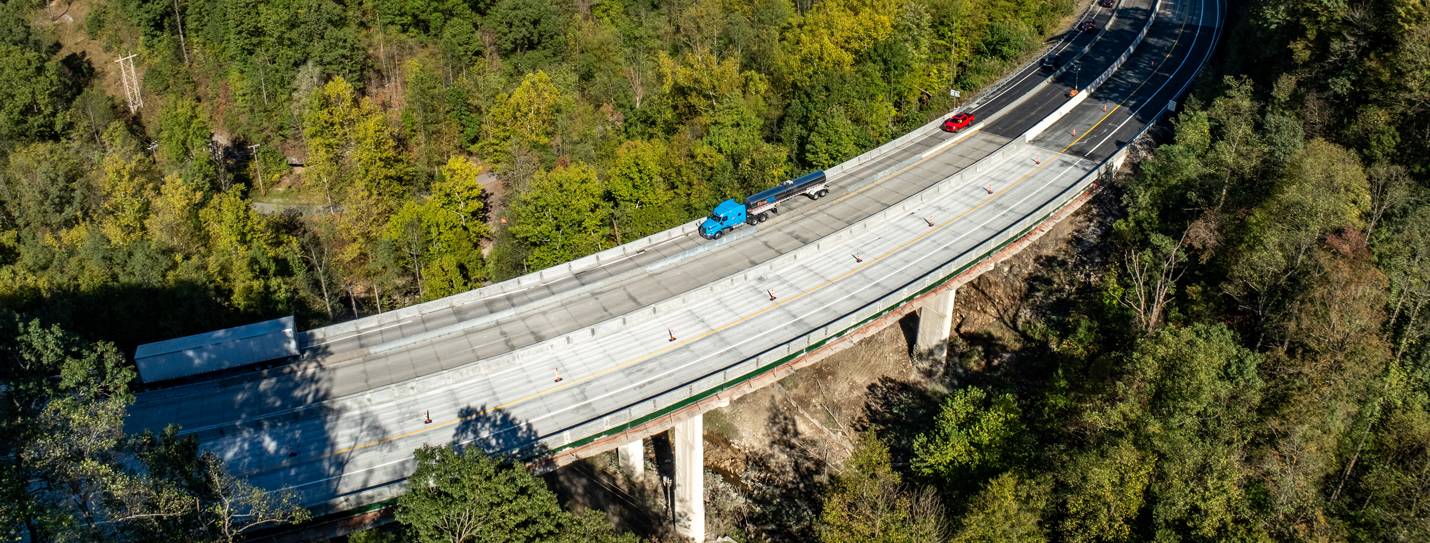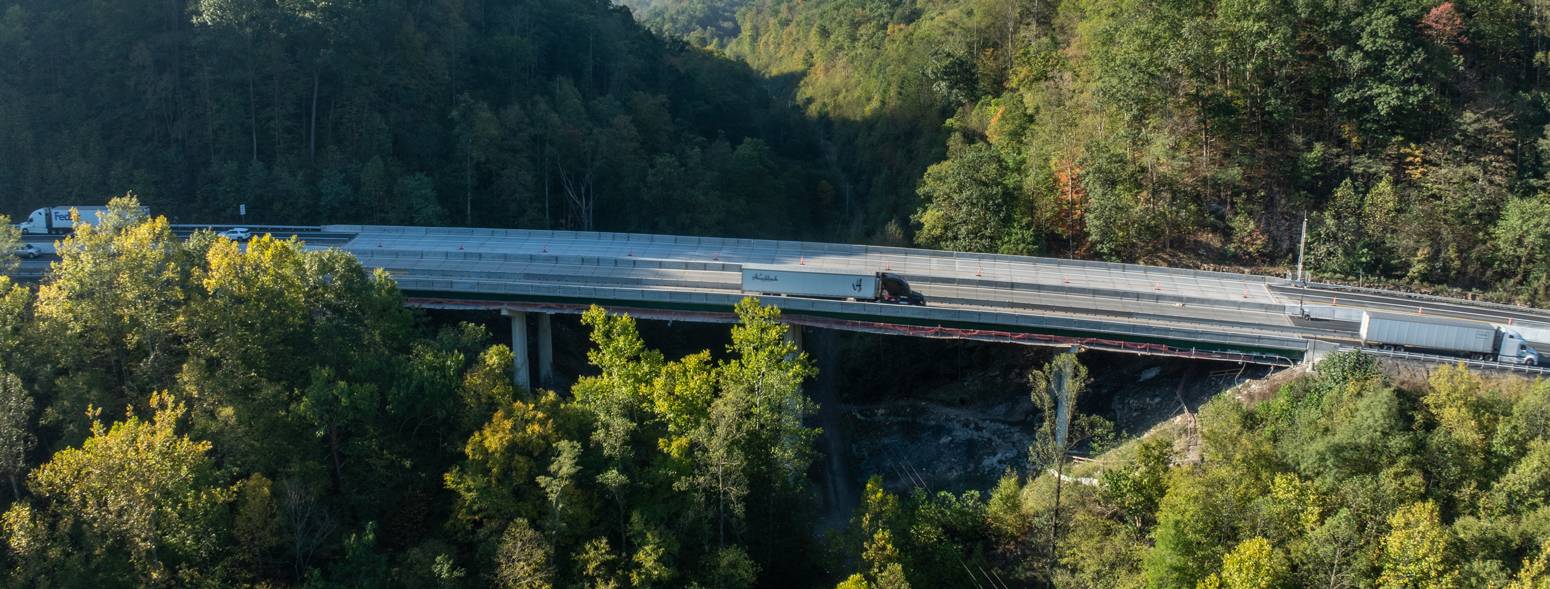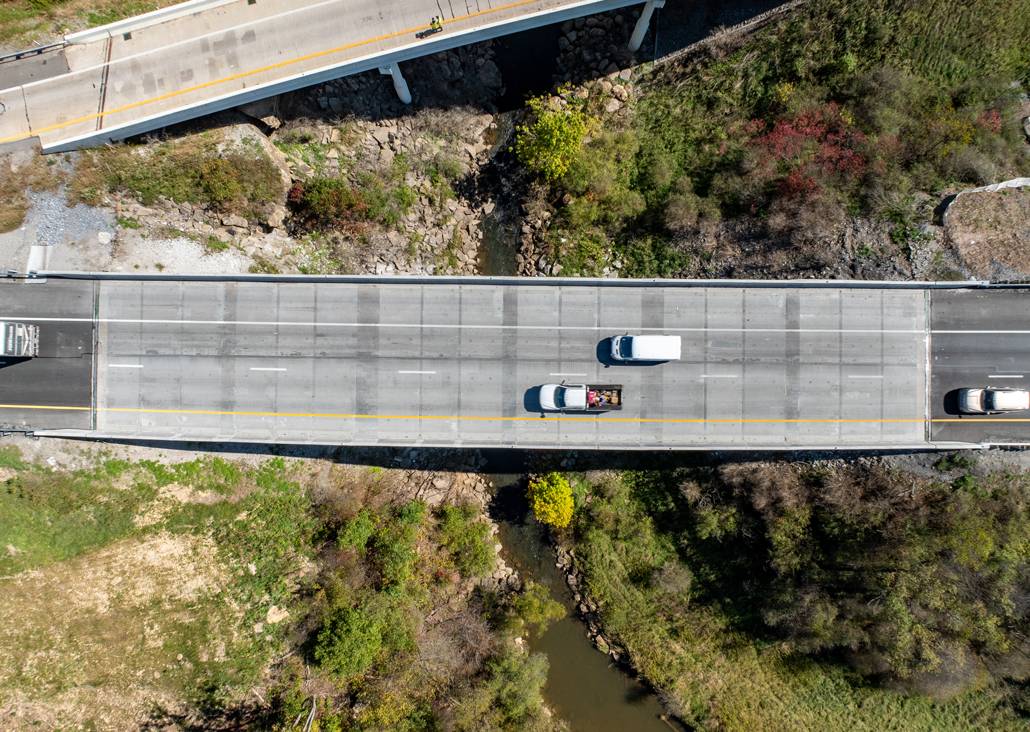


Accelerated bridge construction ensures the West Virginia Turnpike gets critically necessary bridge decks replaced quickly while minimizing disruptions for drivers
DESIGNER
2025
Fifteen years ago, with the West Virginia Turnpike’s bridge infrastructure nearing 40 years old, the West Virginia Parkways Authority began considering how best to address the corridor’s bridge decks while maintaining a safe, reliable roadway.
“In West Virginia, owners typically start replacing bridge decks at around 40 to 50 years of age due to the impact of the de-icing chemicals used on the roads,” said Bill Manuel, HNTB bridge deck replacement program manager. “A possible approach for some bridge decks is to be patched; however, postponing replacement would create a need down the road for 40 or 50 decks to be replaced within a matter of just a few years. The Authority preferred to be proactive.”
Starting in 2012, HNTB, the Authority’s general engineering consultant since 1955, reviewed decades of turnpike bridge inspection data and completed chloride and compressive strength testing and petrographic analyses on the turnpike bridges. The firm then developed a matrix that assigned deck sufficiency ratings and deck scores for each bridge on the corridor and established a worst-to-best hierarchy.
Based on that data, the Authority approved a program to replace all 116 bridge decks and began setting aside funds to complete the work over the next 30 years.
Taking advantage of short construction windows
The West Virginia Turnpike, an 88-mile, four-lane toll road between Princeton and Charleston, West Virginia, is the direct route south from the Great Lakes and parts of Canada. Portions of both Interstate 77 and Interstate 64 are carried on this route.
Unlike most tolling facilities across the U.S., the West Virginia Turnpike’s highest traffic volumes occur during the summer, rather than during daily rush hour periods as commuters drive to and from work.
“The West Virginia Turnpike is probably one of the more unique toll roadways in the entire country,” said West Virginia Parkways Authority Interim Executive Director Parrish French. “Our traffic peaks in the summertime, when a lot of people travel from the Great Lakes region to the southeast for vacation or to visit family and friends. We experience more than one third of our traffic for the entire year from Memorial Day to Labor Day.”
When transportation agencies replace decks, one approach is to close one side of the bridge, replace the deck on those lanes and then repeat on the other side. That process, which can require months-long closures, would have presented significant mobility challenges for West Virginia Turnpike.

The Turnpike’s heavy traffic between Memorial Day and Labor Day restricts the types of construction projects the Authority can perform during that period without creating significant traffic backups. The agency has two short windows of time to complete bridge deck replacements – from wintertime to Memorial Day and from Labor Day until wintertime, which can set in quickly in West Virginia.
Another difficulty is the region’s terrain, which leaves little real estate available for staging materials and construction equipment. The Turnpike cuts through mountains and valleys, with a creek that runs alongside a large portion of the roadway.
The solution to those challenges was accelerated bridge construction, or ABC, which allows contractors to prefabricate bridge deck panels in an offsite, climate-controlled location, stage them near the designated bridge and work around the clock to install the panels, locking them together with ultra-high-performance concrete. Contractors grind off about ¾ inch for smoothness and add a high-friction surface treatment atop the deck.
ABC limits traffic disruptions in most cases to one to two weeks per bridge. Two recently completed projects – the Skitter Creek and Cabin Creek bridges – are the largest and most complicated spans on the corridor. Both go uphill and downhill, with curved turns. Redecking them required 40-day closures.
The Authority has added other efficiencies into the project as well. For example, without a separate road closure, median barrier wall heights often are increased when the bridges are redecked.


“We are getting critically necessary work completed in an unbelievably quick amount of time. It’s an impressive project that is achieving our most important goal: to provide the best and safest experience for patrons on our roadway.”
“We look at each bridge individually and use data from the last decade to understand how long a deck replacement will take and what steps are needed to address the individual structure.”
Delivering long-term value
To effectively manage the work in the brief times available, the Authority has replaced about four decks per year. The first was completed in 2016, and, since then, 23 more decks have been replaced.
The use of specific materials also helps minimize construction time and complete these projects within preferred seasonal windows.
Precast panels offer other benefits that customary methods don’t. They deliver improved durability and reduced maintenance costs over time. Their modular nature allows for better coordination and planning that leads to a more predictable project schedule and increased precision during installation. They provide safety benefits by removing workers from active construction sites any longer than necessary.
Planning ahead and managing complexities
Determining the order in which decks will be replaced is a dynamic process. At the end of each year, HNTB compares the annual hours Authority workers spent maintaining each bridge with the newest annual inspection data and the Federal Highway Administration scores listed on the matrix. Always looking a couple of years ahead, HNTB then recommends which bridges should be prioritized for deck replacement.
After the Authority has had input on the recommendations — which may include moving bridges up or down the list based on additional considerations — and the team has agreed on the order in which decks need to be replaced, HNTB begins the design.
“Our local HNTB team has the expertise and knowledge to start designing a couple of years in advance,” French said. “They hold pre-construction meetings with the contractors. The most impressive part is the schedule they set forth of how, when and why work needs to get done. Contractors are made aware of this schedule from day one.”
Most bridges on the corridor differ significantly from each other, with variances including skewed, curved, straight and concrete girders, length and composite versus non-composite materials. Additional engineering effort is necessary, primarily in the detailing required to make the ABC process go smoothly.

“We tackle the complexities of each structure during the pre-ABC phase,” Manuel said. “The panels are different from one bridge to the next. When bridges offer good construction access, large cranes can move large panels, requiring less fabrication and fewer closure joints. When we don’t have good crane access, we need to use more and smaller panels, requiring more time to set and more closure forms. We look at each bridge individually and use data from the last decade to understand how long a deck replacement will take and what steps are needed to address the individual structure.”
“A mistake in the pre-production phase can cause a project delay that defeats the purpose of using an accelerated process,” French said. “HNTB spends months working on the pre-ABC phase to ensure the panels, the traffic flow design and other details are right. They know exactly what our needs and expectations are, and they always deliver these projects to our satisfaction. We all understand the importance of completing these extremely complicated projects as promised, and HNTB is as committed to this as anyone could possibly be.”
Focusing on constant improvement
As newer materials have become available over the last few years, the Authority and HNTB have optimized design and improved the overall bridge deck replacement program. Ultra-high-performance concrete is one example. When the project began 12 years ago, UHPC was relatively new and took up to 48 hours to cure – more time than the team wanted to allow under ABC.
At the time, rapid-set concrete was used, which set up quickly but required closure pours approximately 18 to 24 inches wide. After a dozen or so decks were completed, the UHPC market reported faster cure rates. With the Authority’s approval, the contractor switched to UHPC, shrinking the closure pours to 9 inches and reducing susceptibility to cracking.
“We keep evolving,” Manuel said. “We’re always trying to optimize the details and solutions to make the Turnpike’s bridge replacement program faster and better.”
“The Turnpike’s ABC-driven bridge deck replacement program is a proven strategy,” French said. “It allows the Authority to uphold our promise to our bondholders. We are getting critically necessary work completed in an unbelievably quick amount of time. It’s an impressive project that is achieving our most important goal: to provide the best and safest experience for patrons on our roadway.”
SEE MORE ARTICLES
MORE DESIGNER STORIES
Orlando International Airport Terminal C
Fish Passage
Denver International Airport A-West and B-West Concourses
CID Green Infrastructure Project
KC Levees Program
